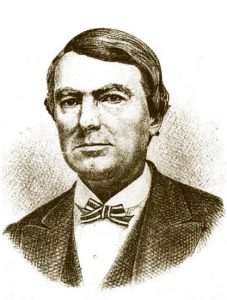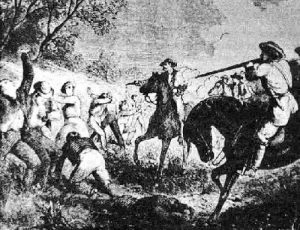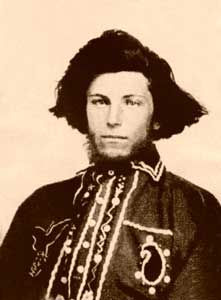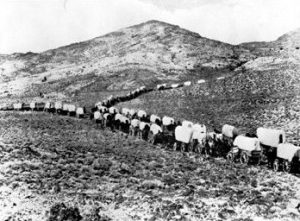Charles H. Withington was an important trader on the Santa Fe Trail in Kansas.
Born in New York in 1816, Charles went to Iowa somewhere along the line, where he married Dorinda White in 1837. At that time, Withington was employed by the government as an Indian Agent to the Sac and Fox Indians.
Withington had been appointed blacksmith at the Mississippi Sac and Fox Racoon River Agency in Iowa Territory in 1838 and continued until the agency moved to a new location near Des Moines.
In the spring of 1846, the Sac and Fox gave up their reservation in Iowa and were moved to present-day Franklin County, Kansas, at which time Withington followed along with his family. He maintained his position as a blacksmith until 1850, when he was appointed gunsmith for the agency. After remaining at the agency for about five years, Withington was appointed as the U.S. mail agent for the Waldo, Hall, and Company on the Santa Fe Trail when he and his family moved to Council Grove, Kansas.
Two years later, in June 1854, just days after the Kansas-Nebraska Act was signed, he moved his family to 142 Mile Creek on the Santa Fe Trail in Lyon County, Kansas. He and his family became the first settlers in the county, soon building a home and opening a store to service the many travelers along the trail. His site was in the extreme northern part of the county, a short distance south of the present-day town of Allen, Kansas. The store was the first one in the county and the only one in southern Kansas outside the regular Indian posts.
Like Fry McGee in adjacent Osage County, Withington violated the Indian Intercourse and Trade Act. Still, between the date that the Kansas-Nebraska Act became law and the official opening of the Territory to settlement, federal authorities turned a blind eye to the encroachment of several settlers.
His place was the headquarters for all the settlers coming to the Neosho Valley the following year. Not known as a ranch or a station, Withington’s enterprise was characterized simply as Withington’s Store. A post office named Allen was added to the store on February 26, 1855, with Withington as postmaster.
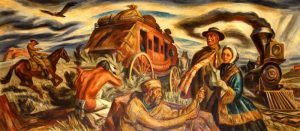
“Pioneers in Kansas,” mural by J. Ward Lockwood, a Kansas native, hangs in the U.S. Federal Building in Wichita, Kansas.
Over the years, the store expanded and served as a hotel and mail station, with a contract with the Hockaday and Hall Stage Company. Additional revenue was derived from a toll bridge that Withington built over 142 Mile Creek and by Withington capitalizing on his old trade of blacksmithing. In addition to the work, he and his wife raised four children.
One later author would describe Withington’s operation: “Would-be settlers looking for claims, found in Mr. Withington’s place of business so good a hotel as the times could afford, and in Mr. Withington himself as accommodating a landlord as his accommodations would allow.”
Withington was influential in the settlement of Lyon County and prominent in several public affairs. In 1855, he was appointed to two local offices — Justice of Peace and Constable. In the same year, he was elected by the Territorial Legislature to serve on his county’s first Board of Commissioners and also elected to the Territorial Council as a Free-State member. However, he was never seated because of the pro-slavery forces which came into power at that time.
During these days, the Sunflower State was known as “Bleeding Kansas,” where settlers fought to make Kansas a “Free-State” or a “Slave State.” Opportunists often raided settlements along the Santa Fe Trail, and on September 15, 1856, a gang representing themselves as Free-Staters looted the store, stealing everything in his possession.
In April 1858, Withington received an agreement to act as the contractor for the building of the Kaw/Kanza Indian Agency House. Before gaining the contact, a Kanza agent contacted his previous supervisor in St. Louis, Missouri — the Superintendent of Indian Affairs to vouch for Withington’s character. The Superintendent responded: “C.H. Withington is a very good, reliable mechanic and a gentleman in every other respect. I, therefore, feel perfectly confident that the job will be done in a good and workmanlike manner.”
What was never disclosed, however, is that the Kanza Indian agent was Withington’s son-in-law. Charles Withington had benefited from this nepotistic arrangement, having been previously hired by his son-in-law to haul the Kanza annuities from Westport, Missouri. On November 6, 1858, the Kanza News of Emporia reported that Charles Withington “has nearly completed a large building to be used as the agency for the Kanza. It is situated at the mouth of Big John Creek, on the road to Council Grove.”
In 1862, during the Civil War, the most noted raid in the history of Lyon County occurred. Judge A. I. Baker, who lived about 13 miles to the west of Withington and operated a store on Rock Creek, had called the notorious Confederate Guerilla “Bloody Bill” Anderson, his father, and brother, Jim, horse thieves, and later was obliged to shoot the elder Anderson in self-defense. At about the same time, a Mexican who belonged to the Anderson gang was hanged by a mob in Americus, Kansas. A few weeks later, the Andersons, with four others, one of whom represented himself to be William Quantrill, came to the Baker home, persuaded him to go to his store to get them some whiskey, and just as he was going down the cellar steps shot him several times. He drew his revolver and inflicted a flesh wound upon Jim Anderson. The ruffians then shot Baker’s brother-in-law, Segur, and threw him into the cellar before piling boxes on the cellar door and setting them on fire. Baker died before the fire reached him, and Segur escaped by a back window but died a few hours later. The fire destroyed Baker’s property, and his horses were stolen.
After several other robberies, the guerrillas came to the residence of Charles Withington at 142 Mile Creek. After placing all the men on the premises under arrest, they demolished the saloon, knocked Withington down with a pistol, and set fire to his house. Owing to the lumber being green, the building did not burn. Jim Anderson seemed determined to kill Withington, but his life was spared through the intercession of William Quantrill and Bill Anderson, the former of whom Mr. Withington recognized, having been somewhat acquainted with him a few years before in Missouri.
Here, they stole three horses from the Kansas City & Santa Fe Mail Company and a rifle belonging to Mr. Withington. They stayed in the area until near daylight, taking prisoners with them. Upon releasing them, Quantrill is reported to have said something like this: “Gentlemen, we now have possession of Kansas, and if I had time, I would issue a proclamation. But, I will only say this much: Let it be remembered that Quantrill disturbs no man who minds his own business.”
After they had completed their hellish work at 142 Mile Creek, the murderers started towards Missouri on the Santa Fe Trail, committing depredations and stealing horses at every point that they passed. At Elm Creek, they fired into the house of a Mr. Jacoby, who had taken some part in getting them arrested. They intended to have killed this gentleman, but a Santa Fe wagon train encamped near Jacoby’s residence saved his life. At the next station, they stole two more horses belonging to the Kansas City & Council Grove Stage Company. From this place, they proceeded on down the road, avoiding Burlingame and threatening a man named Hollam Rice, who kept a stopping place at Dragoon Creek near Burlingame.
At 110 Creek, they compelled Mr. Harris to get breakfast for them in double-quick time, threatening to blow his brains out if he did not. They left there a little after daylight and were probably in Missouri by noon.
Charles Withington continued to operate the store through 1866, when the railroad ended the Santa Fe Trail trade through the area. By this time, he had become a wealthy merchant and continued farming his land in Lyon County until his wife died in May 1880.
Charles then fulfilled a lifelong dream to travel to California to visit his brother, Richard Hall Withington, in Sacramento. He died of cholera in 1881 and was buried in the Historic Sacramento City Cemetery.
© Kathy Alexander/Legends of Kansas, updated September 2023.
Also See:
Santa Fe Trail in Lyon County, Kansas
Sources: See Santa Fe Trail Site Map & Writing Credits

